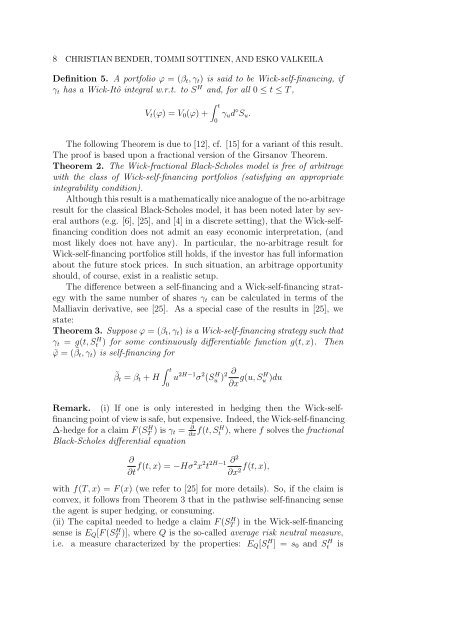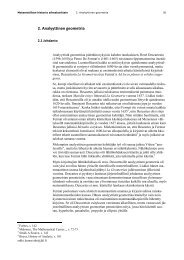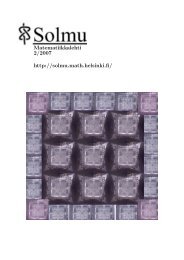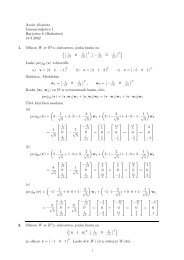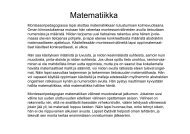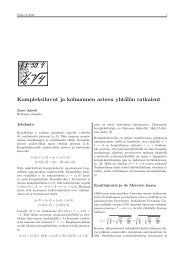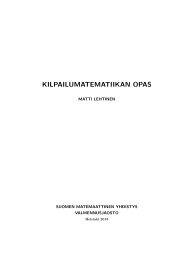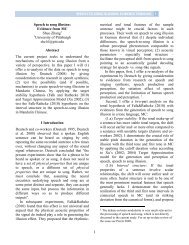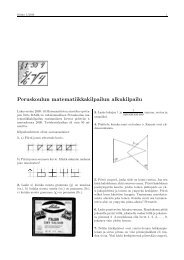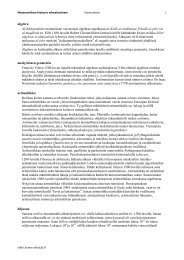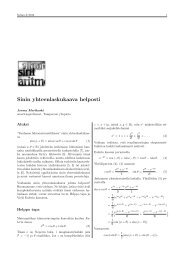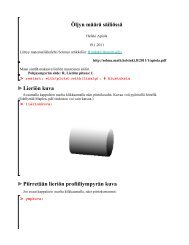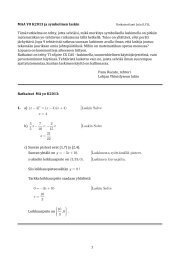ARBITRAGE WITH FRACTIONAL BROWNIAN MOTION?1 - Helsinki.fi
ARBITRAGE WITH FRACTIONAL BROWNIAN MOTION?1 - Helsinki.fi
ARBITRAGE WITH FRACTIONAL BROWNIAN MOTION?1 - Helsinki.fi
Create successful ePaper yourself
Turn your PDF publications into a flip-book with our unique Google optimized e-Paper software.
8 CHRISTIAN BENDER, TOMMI SOTTINEN, AND ESKO VALKEILA<br />
De<strong>fi</strong>nition 5. A portfolio ϕ = (β t , γ t ) is said to be Wick-self-<strong>fi</strong>nancing, if<br />
γ t has a Wick-Itô integral w.r.t. to S H and, for all 0 ≤ t ≤ T ,<br />
V t (ϕ) = V 0 (ϕ) +<br />
∫ t<br />
0<br />
γ u d ⋄ S u .<br />
The following Theorem is due to [12], cf. [15] for a variant of this result.<br />
The proof is based upon a fractional version of the Girsanov Theorem.<br />
Theorem 2. The Wick-fractional Black-Scholes model is free of arbitrage<br />
with the class of Wick-self-<strong>fi</strong>nancing portfolios (satisfying an appropriate<br />
integrability condition).<br />
Although this result is a mathematically nice analogue of the no-arbitrage<br />
result for the classical Black-Scholes model, it has been noted later by several<br />
authors (e.g. [6], [25], and [4] in a discrete setting), that the Wick-self<strong>fi</strong>nancing<br />
condition does not admit an easy economic interpretation, (and<br />
most likely does not have any). In particular, the no-arbitrage result for<br />
Wick-self-<strong>fi</strong>nancing portfolios still holds, if the investor has full information<br />
about the future stock prices. In such situation, an arbitrage opportunity<br />
should, of course, exist in a realistic setup.<br />
The difference between a self-<strong>fi</strong>nancing and a Wick-self-<strong>fi</strong>nancing strategy<br />
with the same number of shares γ t can be calculated in terms of the<br />
Malliavin derivative, see [25]. As a special case of the results in [25], we<br />
state:<br />
Theorem 3. Suppose ϕ = (β t , γ t ) is a Wick-self-<strong>fi</strong>nancing strategy such that<br />
γ t = g(t, S H t ) for some continuously differentiable function g(t, x). Then<br />
˜ϕ = ( ˜β t , γ t ) is self-<strong>fi</strong>nancing for<br />
˜β t = β t + H<br />
∫ t<br />
0<br />
u 2H−1 σ 2 (S H u ) 2 ∂<br />
∂x g(u, SH u )du<br />
Remark. (i) If one is only interested in hedging then the Wick-self<strong>fi</strong>nancing<br />
point of view is safe, but expensive. Indeed, the Wick-self-<strong>fi</strong>nancing<br />
∆-hedge for a claim F (ST H ) is γ t = ∂ f(t, ∂x SH t ), where f solves the fractional<br />
Black-Scholes differential equation<br />
∂<br />
∂t f(t, x) = −Hσ2 x 2 t<br />
2H−1 ∂2<br />
f(t, x),<br />
∂x2 with f(T, x) = F (x) (we refer to [25] for more details). So, if the claim is<br />
convex, it follows from Theorem 3 that in the pathwise self-<strong>fi</strong>nancing sense<br />
the agent is super hedging, or consuming.<br />
(ii) The capital needed to hedge a claim F (S H T ) in the Wick-self-<strong>fi</strong>nancing<br />
sense is E Q [F (S H T )], where Q is the so-called average risk neutral measure,<br />
i.e. a measure characterized by the properties: E Q [S H t ] = s 0 and S H t is


